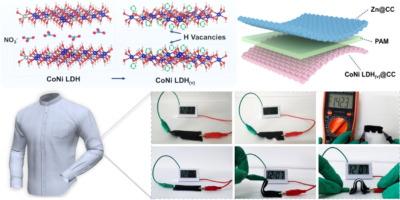A mild, configurable, flexible CoNi-LDH(v)/Zn battery based on H-vacancy-induced reversible Zn2+ intercalation
IF 13.1
1区 化学
Q1 Energy
引用次数: 0
Abstract
Flexible Zn-based batteries have attracted increasing research interest as essential components of wearable energy storage devices. However, the advancement of flexible aqueous Zn-based batteries based on Co-Ni layered double hydroxide (CoNi-LDH) as the cathode material is hampered by their poor cycling stability and the corrosiveness of alkaline electrolytes. Herein, CoNi-LDH nanosheets enriched with H vacancies (CoNi-LDH(v)) were constructed on a flexible carbon cloth (CC) substrate via electrochemical deposition and activation. The Zn-based battery comprising CoNi-LDH(v)@CC as the cathode exhibited highly reversible conversion reactions and stable operation in 3 M ZnSO4 electrolyte (pH = 4). The battery delivered an excellent specific capacity (225 mA h g−1, 0.26 mA h cm−2), acceptable cycling stability (53.9%, 900 cycles), and high discharging voltage. The abundant H vacancies served as active sites for the reversible intercalation of Zn2+ and the extravasation of NO3− generated channels and space for Zn2+ transport and storage, together enabling an excellent Zn2+ storage capacity. Furthermore, a sandwich-structured solid-state CoNi-LDH(v)@CC//Zn@CC battery was fabricated and was found to exhibit a noteworthy electrochemical performance and mechanical durability. As a proof of concept, the unencapsulated battery powered a digital watch under various deformation conditions and operated stably for 80 h. Additionally, the flexible battery displayed outstanding customizability, maintaining an open-circuit voltage of 1.42 V even after being cut twice. The proposed engineering strategy contributes to the realization of textiles with truly wearable energy-storage devices.

基于氢空位诱导的可逆 Zn2+ 插层的温和、可配置、灵活的 CoNi-LDH(v)/Zn 电池
作为可穿戴储能设备的重要组成部分,柔性锌基电池吸引了越来越多的研究兴趣。然而,以钴镍层状双氢氧化物(CoNi-LDH)为正极材料的柔性锌基水溶液电池循环稳定性差,且易受碱性电解质的腐蚀,这阻碍了其发展。本文通过电化学沉积和活化,在柔性碳布(CC)基底上构建了富含 H 空位(CoNi-LDH(v))的 CoNi-LDH 纳米片。以 CoNi-LDH(v)@CC 为阴极的锌基电池在 3 M ZnSO4 电解液(pH = 4)中表现出高度可逆的转换反应和稳定的运行。该电池具有出色的比容量(225 mA h g-1,0.26 mA h cm-2)、可接受的循环稳定性(53.9%,900 次循环)和较高的放电电压。丰富的 H 空位是 Zn2+ 可逆插层的活性位点,而 NO3- 的外渗则为 Zn2+ 的传输和储存提供了通道和空间,从而实现了出色的 Zn2+ 储存能力。此外,还制备了一种夹层结构的 CoNi-LDH(v)@CC//Zn@CC 固态电池,并发现该电池具有显著的电化学性能和机械耐久性。作为概念验证,未封装电池在各种变形条件下为数字手表供电,并稳定工作了 80 小时。此外,柔性电池显示出出色的可定制性,即使被切割两次后仍能保持 1.42 V 的开路电压。所提出的工程策略有助于实现具有真正可穿戴储能装置的纺织品。
本文章由计算机程序翻译,如有差异,请以英文原文为准。
求助全文
约1分钟内获得全文
求助全文
来源期刊

Journal of Energy Chemistry
CHEMISTRY, APPLIED-CHEMISTRY, PHYSICAL
CiteScore
19.10
自引率
8.40%
发文量
3631
审稿时长
15 days
期刊介绍:
The Journal of Energy Chemistry, the official publication of Science Press and the Dalian Institute of Chemical Physics, Chinese Academy of Sciences, serves as a platform for reporting creative research and innovative applications in energy chemistry. It mainly reports on creative researches and innovative applications of chemical conversions of fossil energy, carbon dioxide, electrochemical energy and hydrogen energy, as well as the conversions of biomass and solar energy related with chemical issues to promote academic exchanges in the field of energy chemistry and to accelerate the exploration, research and development of energy science and technologies.
This journal focuses on original research papers covering various topics within energy chemistry worldwide, including:
Optimized utilization of fossil energy
Hydrogen energy
Conversion and storage of electrochemical energy
Capture, storage, and chemical conversion of carbon dioxide
Materials and nanotechnologies for energy conversion and storage
Chemistry in biomass conversion
Chemistry in the utilization of solar energy
 求助内容:
求助内容: 应助结果提醒方式:
应助结果提醒方式:


